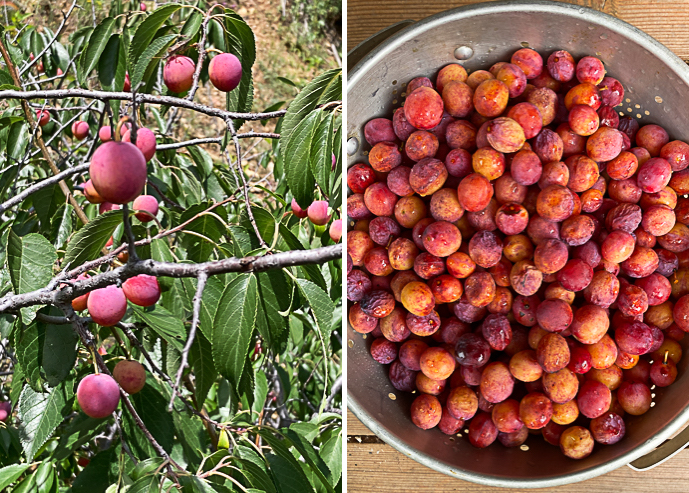
I’ve had my eye on this patch of plums since last spring, when their bright white flowers made them easy to spot at 40 miles an hour. Patience is not my strong suit, and I worried someone might beat me to the harvest. But I waited because that’s what you have to do with wild plums.
You may read that wild plums are of poor quality and very astringent, that they require loads of sugar to make them palatable, and that it’s essential to remove the skins before cooking with them. I used to believe all of that. I don’t any more.
The key to a good wild plum harvest is patience. Picked even a week early, the fruit may indeed be so astringent it makes you wonder if you’ve wasted your time. Just wait. A ripe plum will fall into your hand at the slightest touch. If you have to tug on the fruit, it’s not ready. Check the ground around the plum bushes. If you see some fallen fruit…your timing is good.
Don’t worry if the fruit looks a little shrivelled; a wrinkled plum skin is a good indication that the fruit is fully ripe. In the first photo above, the full, plump plums aren’t quite ready to be picked. The slightly wrinkled fruit in the colander is perfect! These two photos were taken four days apart.
Wild plums are MUCH smaller than cultivated fruit. Mine are less than an inch in diameter (although they may grow to be slightly larger in places with more rainfall and better soil) and range in color from yellow to orange to pink to red. The flesh inside is orange and makes a lovely jam, jelly, or ketchup. I’m not 100% sure, but I believe mine may be headed for plum jam with a hint of Chimayo red chile.
The fruit isn’t the only tasty harvest you’ll get from a wild plum. Wild plum flowers are intoxicatingly fragrant, and make a superb liqueur. They also infuse wonderfully in cream for a plum blossom panna cotta. But don’t take all the flowers, or you won’t find any fruit later in the season.
Plant the pits about 2 inches deep in well drained soil and in about 6 years you will have production which will double every year for 5 or 10 years Germination rate will be about 50%. Survival of seedlings will be about 50% so plant extras. In a greenhouse in pots one can do much better but it’s a lot more work.. Keep them from drying out. Protect them from rodents and deer.
In south Georgia these use to grow along the highways. Mine are usually ready by early to mid May. If picked to early they are tart but if you have patience and wait then they are as sweet as can be. The bush/tree will sprout off the roots of the other bushes/trees. It usually takes about 3 to 4 years and the new sprout will produce a few. The deer love them as well as the birds and squirrels. The best time to replant them is in the fall.
I love hearing about different parts of the country and their foraging seasons. Here in northern NM our wild plums have just finished blooming and I won’t see fruit until the second half of August/early September. And I agree about waiting. Too many people harvest them not-quite-ripe and are disappointed with the flavor. I wait, and find them delicious! Glad you do, too.